roof NISSAN TITAN 2017 2.G Owners Manual
[x] Cancel search | Manufacturer: NISSAN, Model Year: 2017, Model line: TITAN, Model: NISSAN TITAN 2017 2.GPages: 671, PDF Size: 7.96 MB
Page 11 of 671
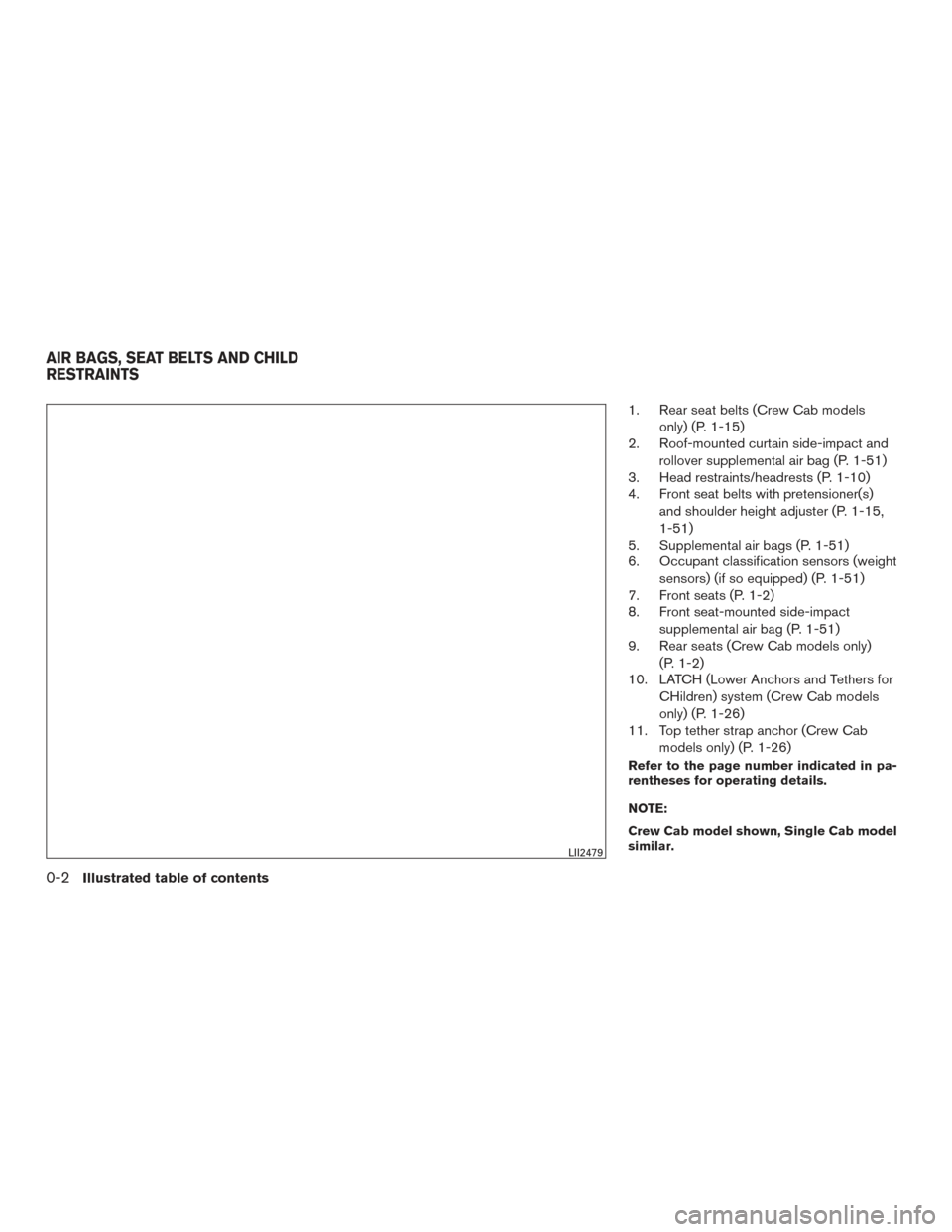
1. Rear seat belts (Crew Cab modelsonly) (P. 1-15)
2. Roof-mounted curtain side-impact and
rollover supplemental air bag (P. 1-51)
3. Head restraints/headrests (P. 1-10)
4. Front seat belts with pretensioner(s)
and shoulder height adjuster (P. 1-15,
1-51)
5. Supplemental air bags (P. 1-51)
6. Occupant classification sensors (weight
sensors) (if so equipped) (P. 1-51)
7. Front seats (P. 1-2)
8. Front seat-mounted side-impact
supplemental air bag (P. 1-51)
9. Rear seats (Crew Cab models only)
(P. 1-2)
10. LATCH (Lower Anchors and Tethers for
CHildren) system (Crew Cab models
only) (P. 1-26)
11. Top tether strap anchor (Crew Cab
models only) (P. 1-26)
Refer to the page number indicated in pa-
rentheses for operating details.
NOTE:
Crew Cab model shown, Single Cab model
similar.
LII2479
AIR BAGS, SEAT BELTS AND CHILD
RESTRAINTS
0-2Illustrated table of contents
Page 24 of 671
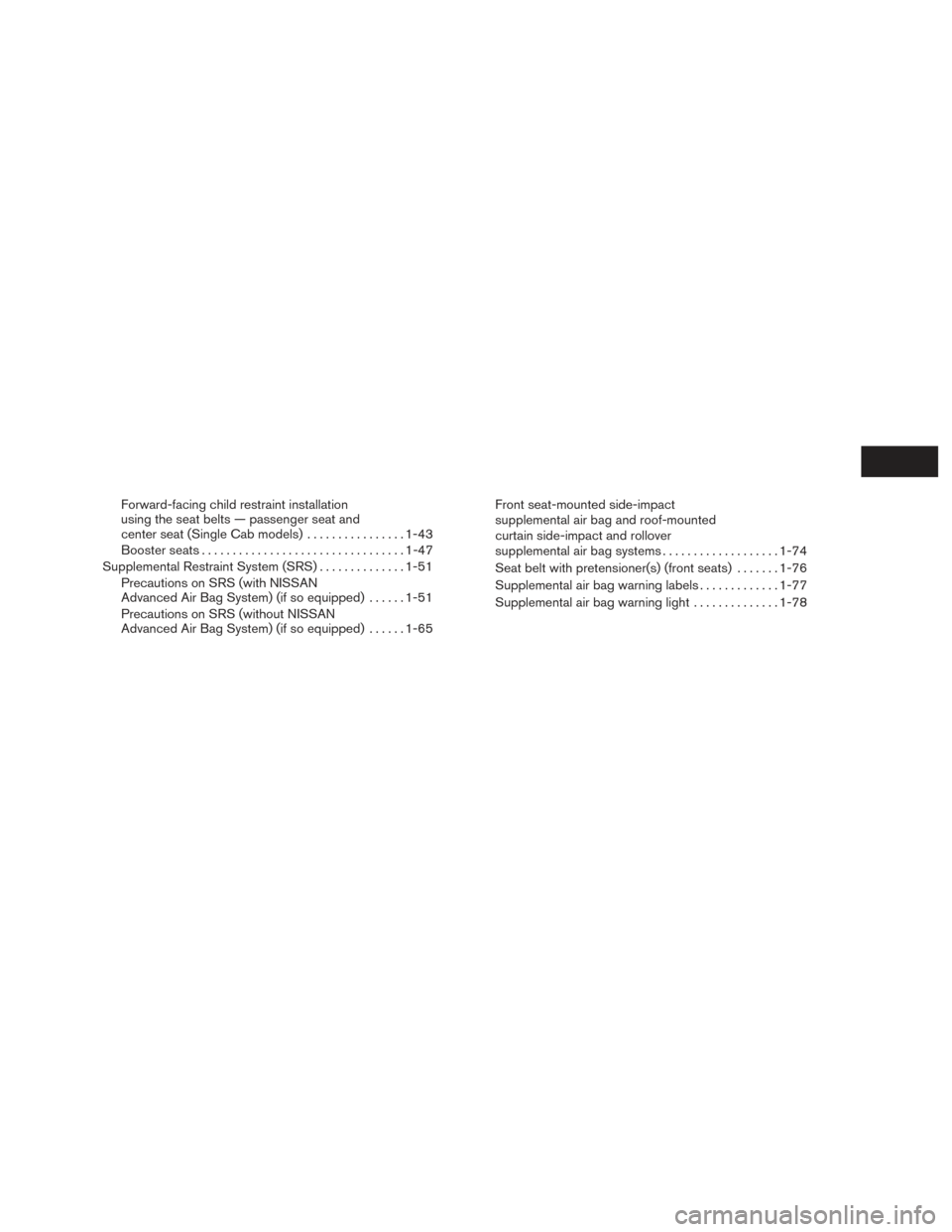
Forward-facing child restraint installation
using the seat belts — passenger seat and
center seat (Single Cab models)................1-43
Booster seats ................................. 1-47
Supplemental Restraint System (SRS) ..............1-51
Precautions on SRS (with NISSAN
Advanced Air Bag System) (if so equipped) ......1-51
Precautions on SRS (without NISSAN
Advanced Air Bag System) (if so equipped) ......1-65 Front seat-mounted side-impact
supplemental air bag and roof-mounted
curtain side-impact and rollover
supplemental air bag systems
...................1-74
Seat belt with pretensioner(s) (front seats) .......1-76
Supplemental air bag warning labels .............1-77
Supplemental air bag warning light ..............1-78
Page 74 of 671
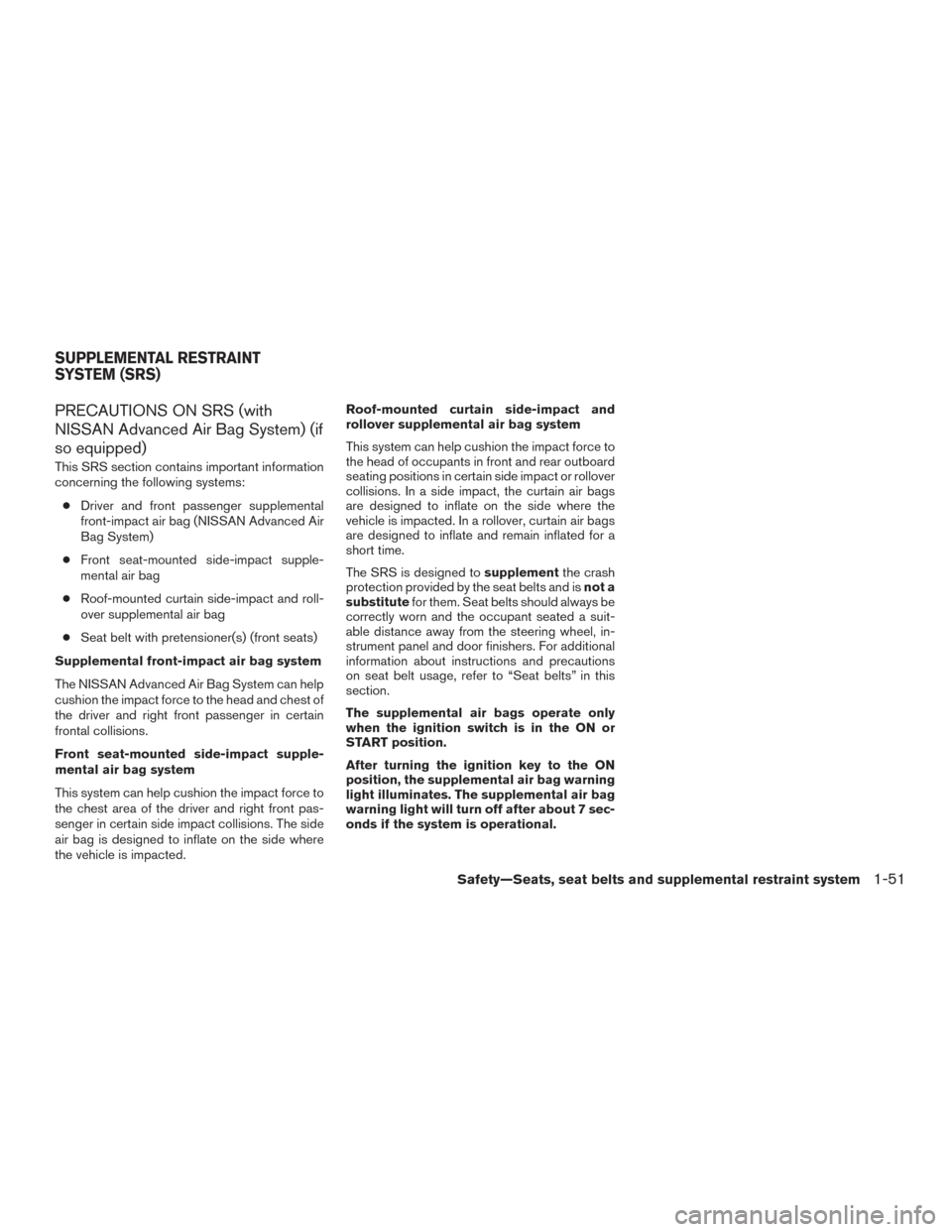
PRECAUTIONS ON SRS (with
NISSAN Advanced Air Bag System) (if
so equipped)
This SRS section contains important information
concerning the following systems:● Driver and front passenger supplemental
front-impact air bag (NISSAN Advanced Air
Bag System)
● Front seat-mounted side-impact supple-
mental air bag
● Roof-mounted curtain side-impact and roll-
over supplemental air bag
● Seat belt with pretensioner(s) (front seats)
Supplemental front-impact air bag system
The NISSAN Advanced Air Bag System can help
cushion the impact force to the head and chest of
the driver and right front passenger in certain
frontal collisions.
Front seat-mounted side-impact supple-
mental air bag system
This system can help cushion the impact force to
the chest area of the driver and right front pas-
senger in certain side impact collisions. The side
air bag is designed to inflate on the side where
the vehicle is impacted. Roof-mounted curtain side-impact and
rollover supplemental air bag system
This system can help cushion the impact force to
the head of occupants in front and rear outboard
seating positions in certain side impact or rollover
collisions. In a side impact, the curtain air bags
are designed to inflate on the side where the
vehicle is impacted. In a rollover, curtain air bags
are designed to inflate and remain inflated for a
short time.
The SRS is designed to
supplementthe crash
protection provided by the seat belts and is not a
substitute for them. Seat belts should always be
correctly worn and the occupant seated a suit-
able distance away from the steering wheel, in-
strument panel and door finishers. For additional
information about instructions and precautions
on seat belt usage, refer to “Seat belts” in this
section.
The supplemental air bags operate only
when the ignition switch is in the ON or
START position.
After turning the ignition key to the ON
position, the supplemental air bag warning
light illuminates. The supplemental air bag
warning light will turn off after about 7 sec-
onds if the system is operational.
SUPPLEMENTAL RESTRAINT
SYSTEM (SRS)
Safety—Seats, seat belts and supplemental restraint system1-51
Page 79 of 671
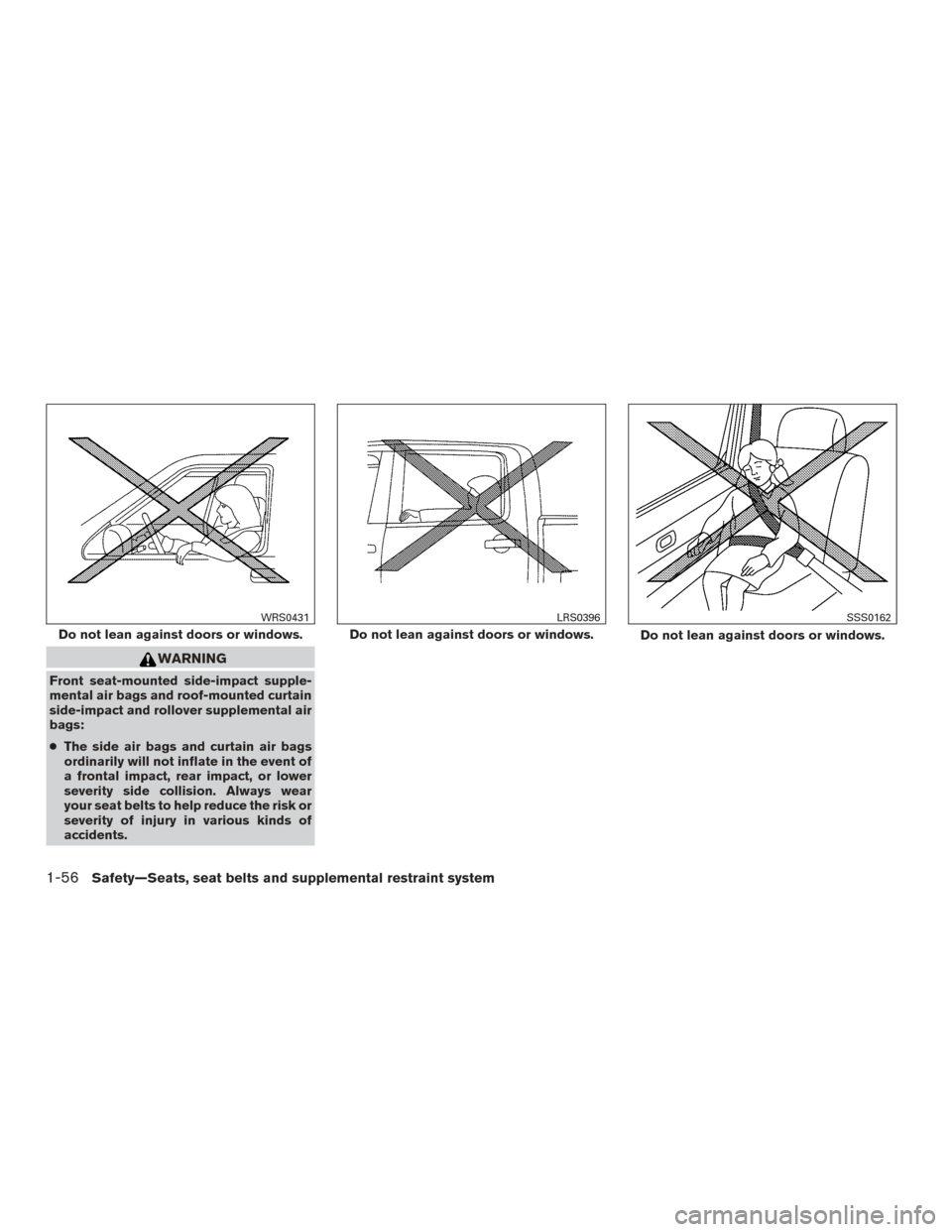
WARNING
Front seat-mounted side-impact supple-
mental air bags and roof-mounted curtain
side-impact and rollover supplemental air
bags:
●The side air bags and curtain air bags
ordinarily will not inflate in the event of
a frontal impact, rear impact, or lower
severity side collision. Always wear
your seat belts to help reduce the risk or
severity of injury in various kinds of
accidents.
Do not lean against doors or windows.
WRS0431
Do not lean against doors or windows.
LRS0396
Do not lean against doors or windows.
SSS0162
1-56Safety—Seats, seat belts and supplemental restraint system
Page 80 of 671
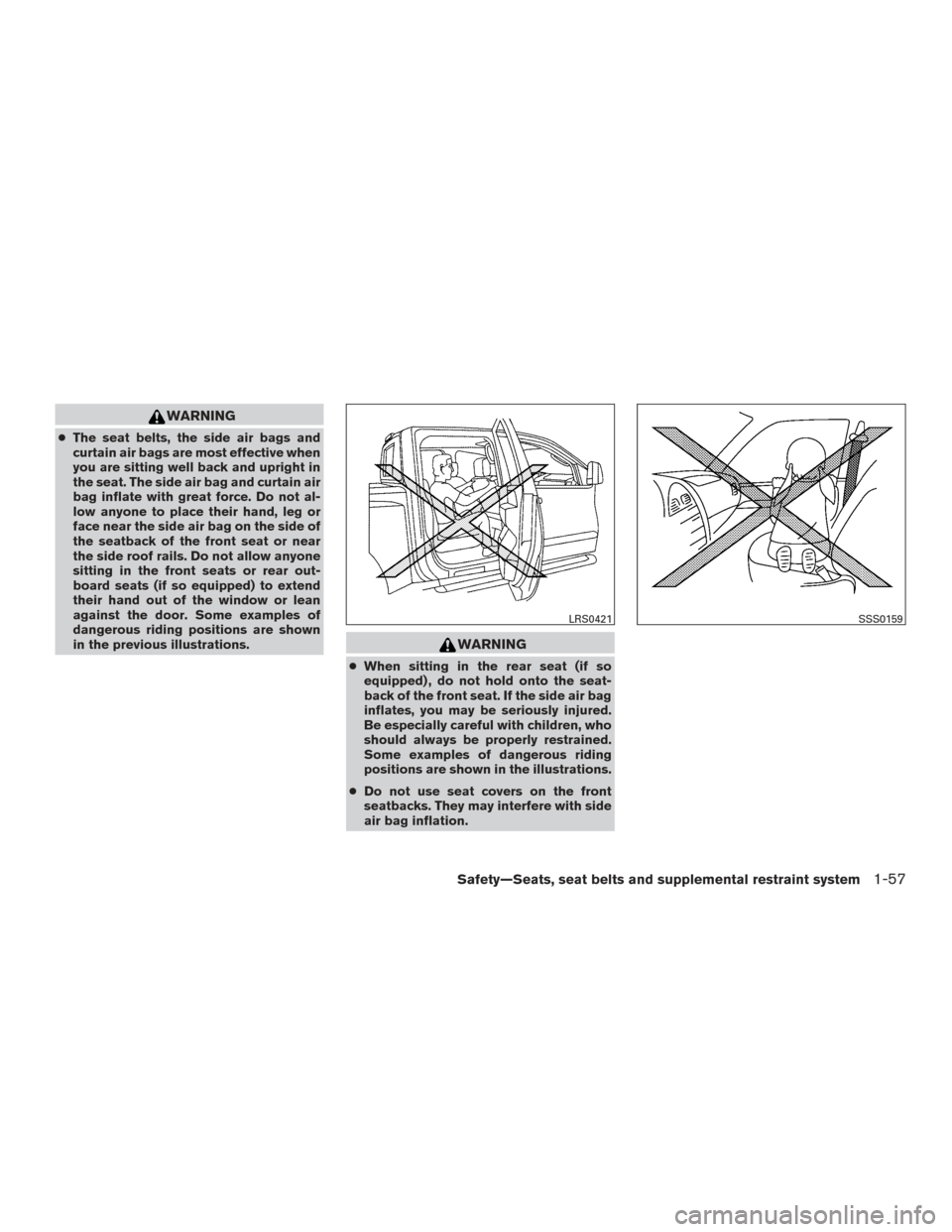
WARNING
●The seat belts, the side air bags and
curtain air bags are most effective when
you are sitting well back and upright in
the seat. The side air bag and curtain air
bag inflate with great force. Do not al-
low anyone to place their hand, leg or
face near the side air bag on the side of
the seatback of the front seat or near
the side roof rails. Do not allow anyone
sitting in the front seats or rear out-
board seats (if so equipped) to extend
their hand out of the window or lean
against the door. Some examples of
dangerous riding positions are shown
in the previous illustrations.
WARNING
● When sitting in the rear seat (if so
equipped) , do not hold onto the seat-
back of the front seat. If the side air bag
inflates, you may be seriously injured.
Be especially careful with children, who
should always be properly restrained.
Some examples of dangerous riding
positions are shown in the illustrations.
● Do not use seat covers on the front
seatbacks. They may interfere with side
air bag inflation.
LRS0421SSS0159
Safety—Seats, seat belts and supplemental restraint system1-57
Page 81 of 671
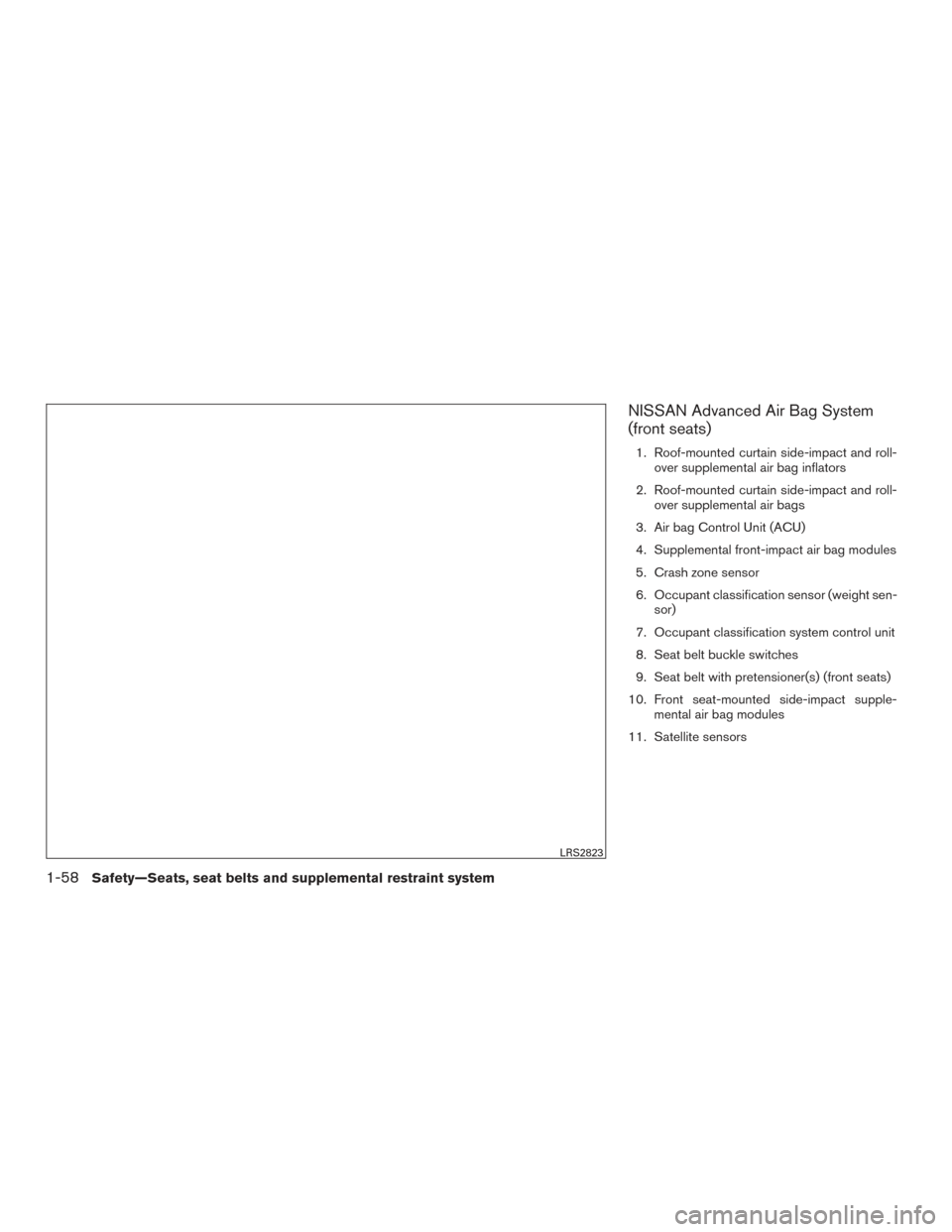
NISSAN Advanced Air Bag System
(front seats)
1. Roof-mounted curtain side-impact and roll-over supplemental air bag inflators
2. Roof-mounted curtain side-impact and roll- over supplemental air bags
3. Air bag Control Unit (ACU)
4. Supplemental front-impact air bag modules
5. Crash zone sensor
6. Occupant classification sensor (weight sen- sor)
7. Occupant classification system control unit
8. Seat belt buckle switches
9. Seat belt with pretensioner(s) (front seats)
10. Front seat-mounted side-impact supple- mental air bag modules
11. Satellite sensors
LRS2823
1-58Safety—Seats, seat belts and supplemental restraint system
Page 88 of 671
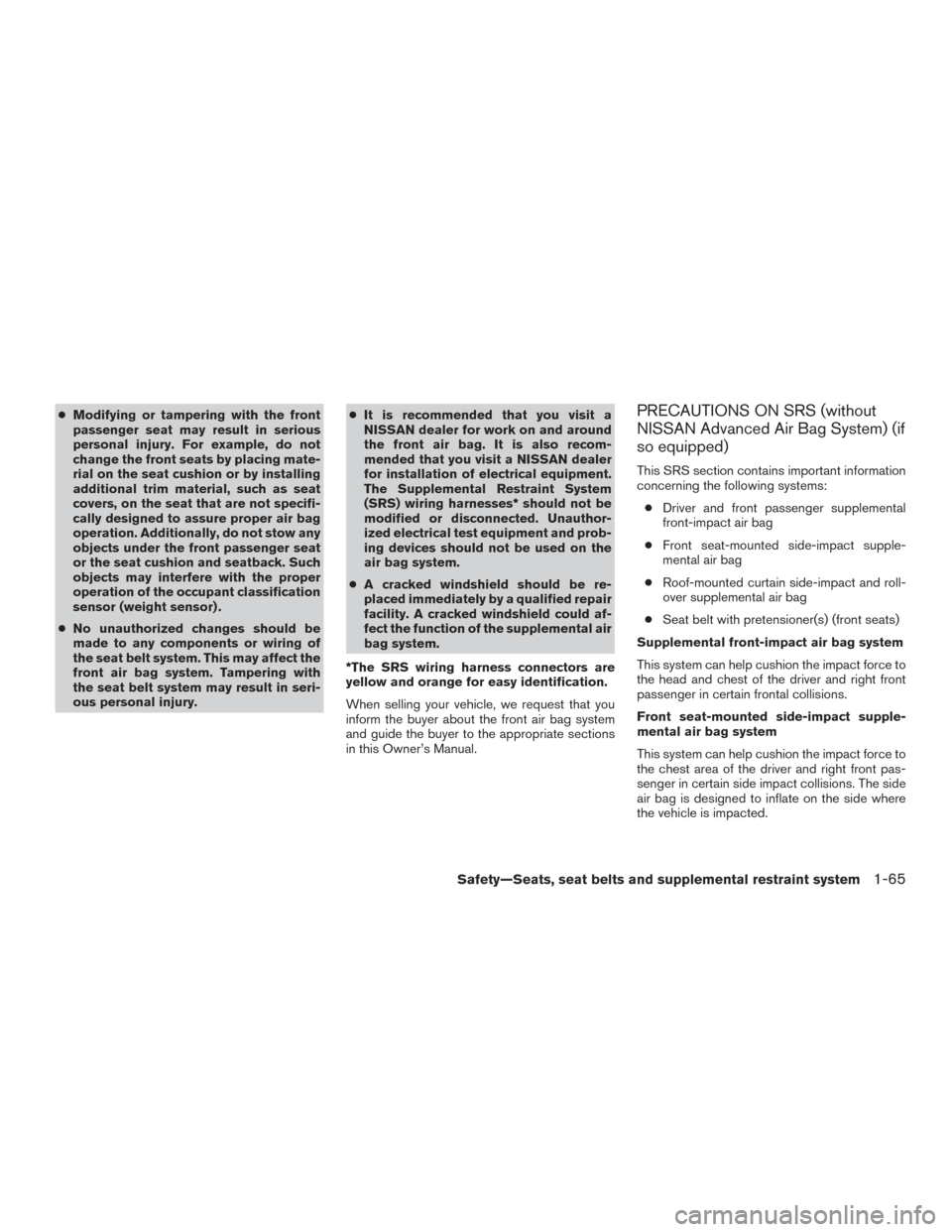
●Modifying or tampering with the front
passenger seat may result in serious
personal injury. For example, do not
change the front seats by placing mate-
rial on the seat cushion or by installing
additional trim material, such as seat
covers, on the seat that are not specifi-
cally designed to assure proper air bag
operation. Additionally, do not stow any
objects under the front passenger seat
or the seat cushion and seatback. Such
objects may interfere with the proper
operation of the occupant classification
sensor (weight sensor) .
● No unauthorized changes should be
made to any components or wiring of
the seat belt system. This may affect the
front air bag system. Tampering with
the seat belt system may result in seri-
ous personal injury. ●
It is recommended that you visit a
NISSAN dealer for work on and around
the front air bag. It is also recom-
mended that you visit a NISSAN dealer
for installation of electrical equipment.
The Supplemental Restraint System
(SRS) wiring harnesses* should not be
modified or disconnected. Unauthor-
ized electrical test equipment and prob-
ing devices should not be used on the
air bag system.
● A cracked windshield should be re-
placed immediately by a qualified repair
facility. A cracked windshield could af-
fect the function of the supplemental air
bag system.
*The SRS wiring harness connectors are
yellow and orange for easy identification.
When selling your vehicle, we request that you
inform the buyer about the front air bag system
and guide the buyer to the appropriate sections
in this Owner’s Manual.PRECAUTIONS ON SRS (without
NISSAN Advanced Air Bag System) (if
so equipped)
This SRS section contains important information
concerning the following systems: ● Driver and front passenger supplemental
front-impact air bag
● Front seat-mounted side-impact supple-
mental air bag
● Roof-mounted curtain side-impact and roll-
over supplemental air bag
● Seat belt with pretensioner(s) (front seats)
Supplemental front-impact air bag system
This system can help cushion the impact force to
the head and chest of the driver and right front
passenger in certain frontal collisions.
Front seat-mounted side-impact supple-
mental air bag system
This system can help cushion the impact force to
the chest area of the driver and right front pas-
senger in certain side impact collisions. The side
air bag is designed to inflate on the side where
the vehicle is impacted.
Safety—Seats, seat belts and supplemental restraint system1-65
Page 89 of 671
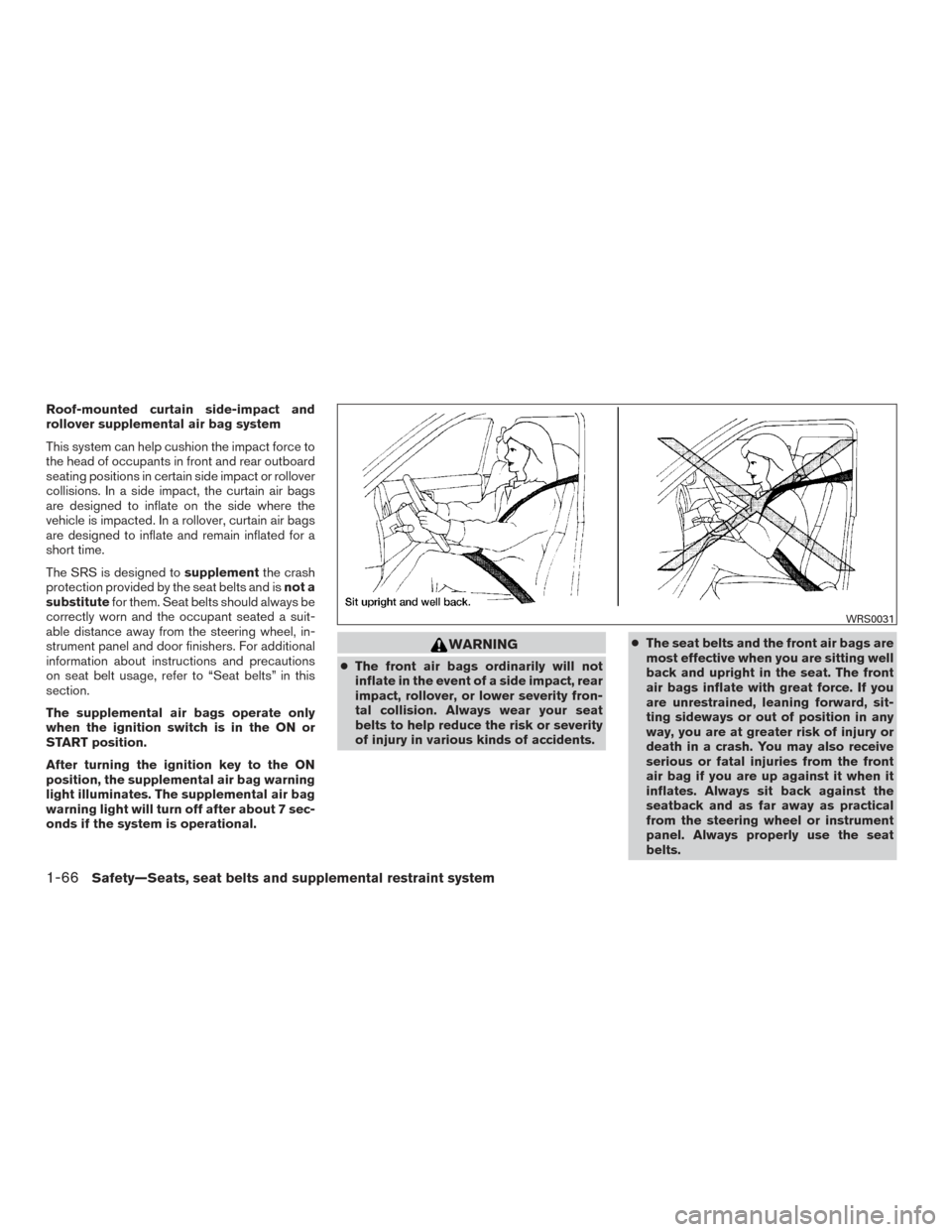
Roof-mounted curtain side-impact and
rollover supplemental air bag system
This system can help cushion the impact force to
the head of occupants in front and rear outboard
seating positions in certain side impact or rollover
collisions. In a side impact, the curtain air bags
are designed to inflate on the side where the
vehicle is impacted. In a rollover, curtain air bags
are designed to inflate and remain inflated for a
short time.
The SRS is designed tosupplementthe crash
protection provided by the seat belts and is not a
substitute for them. Seat belts should always be
correctly worn and the occupant seated a suit-
able distance away from the steering wheel, in-
strument panel and door finishers. For additional
information about instructions and precautions
on seat belt usage, refer to “Seat belts” in this
section.
The supplemental air bags operate only
when the ignition switch is in the ON or
START position.
After turning the ignition key to the ON
position, the supplemental air bag warning
light illuminates. The supplemental air bag
warning light will turn off after about 7 sec-
onds if the system is operational.
WARNING
● The front air bags ordinarily will not
inflate in the event of a side impact, rear
impact, rollover, or lower severity fron-
tal collision. Always wear your seat
belts to help reduce the risk or severity
of injury in various kinds of accidents. ●
The seat belts and the front air bags are
most effective when you are sitting well
back and upright in the seat. The front
air bags inflate with great force. If you
are unrestrained, leaning forward, sit-
ting sideways or out of position in any
way, you are at greater risk of injury or
death in a crash. You may also receive
serious or fatal injuries from the front
air bag if you are up against it when it
inflates. Always sit back against the
seatback and as far away as practical
from the steering wheel or instrument
panel. Always properly use the seat
belts.
WRS0031
1-66Safety—Seats, seat belts and supplemental restraint system
Page 93 of 671
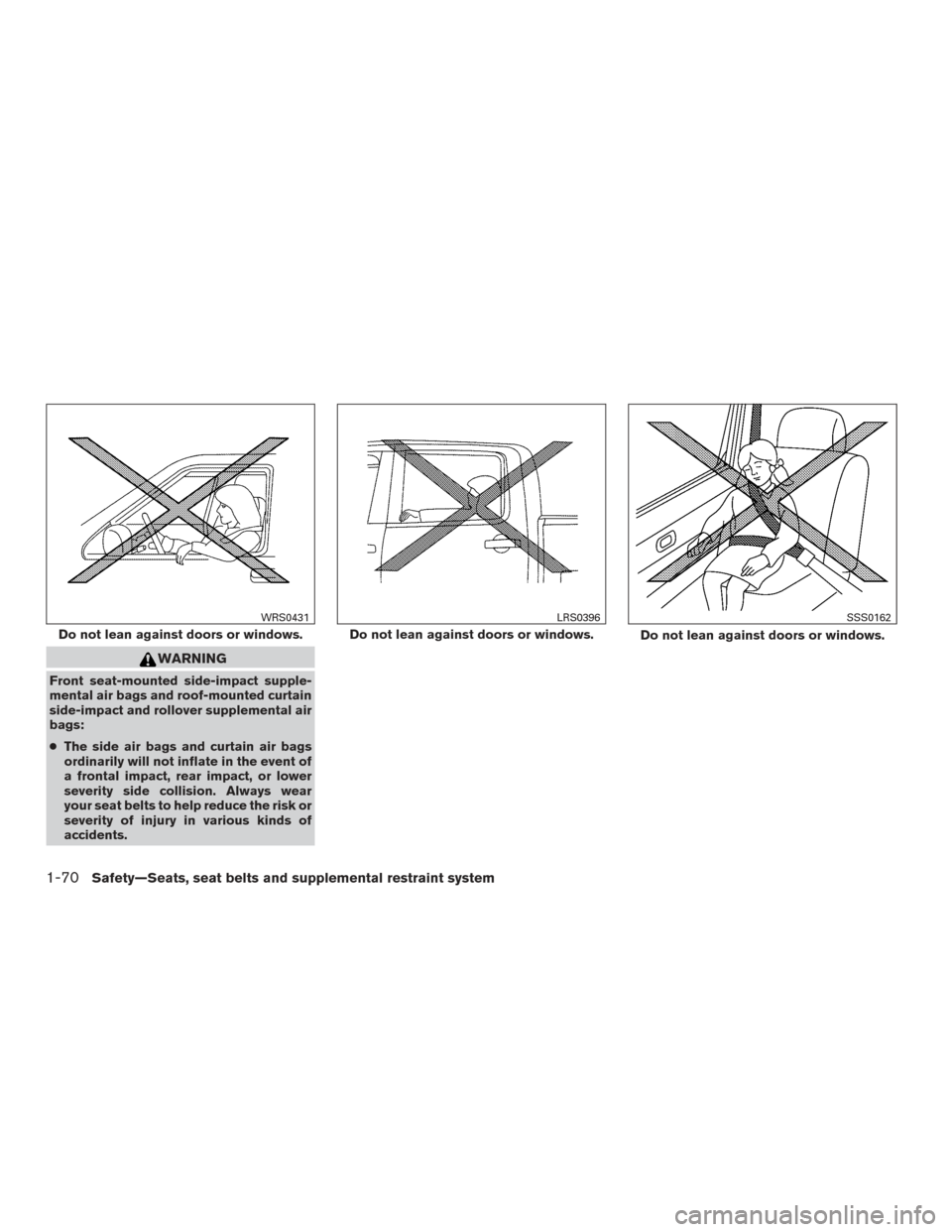
WARNING
Front seat-mounted side-impact supple-
mental air bags and roof-mounted curtain
side-impact and rollover supplemental air
bags:
●The side air bags and curtain air bags
ordinarily will not inflate in the event of
a frontal impact, rear impact, or lower
severity side collision. Always wear
your seat belts to help reduce the risk or
severity of injury in various kinds of
accidents.
Do not lean against doors or windows.
WRS0431
Do not lean against doors or windows.
LRS0396
Do not lean against doors or windows.
SSS0162
1-70Safety—Seats, seat belts and supplemental restraint system
Page 94 of 671
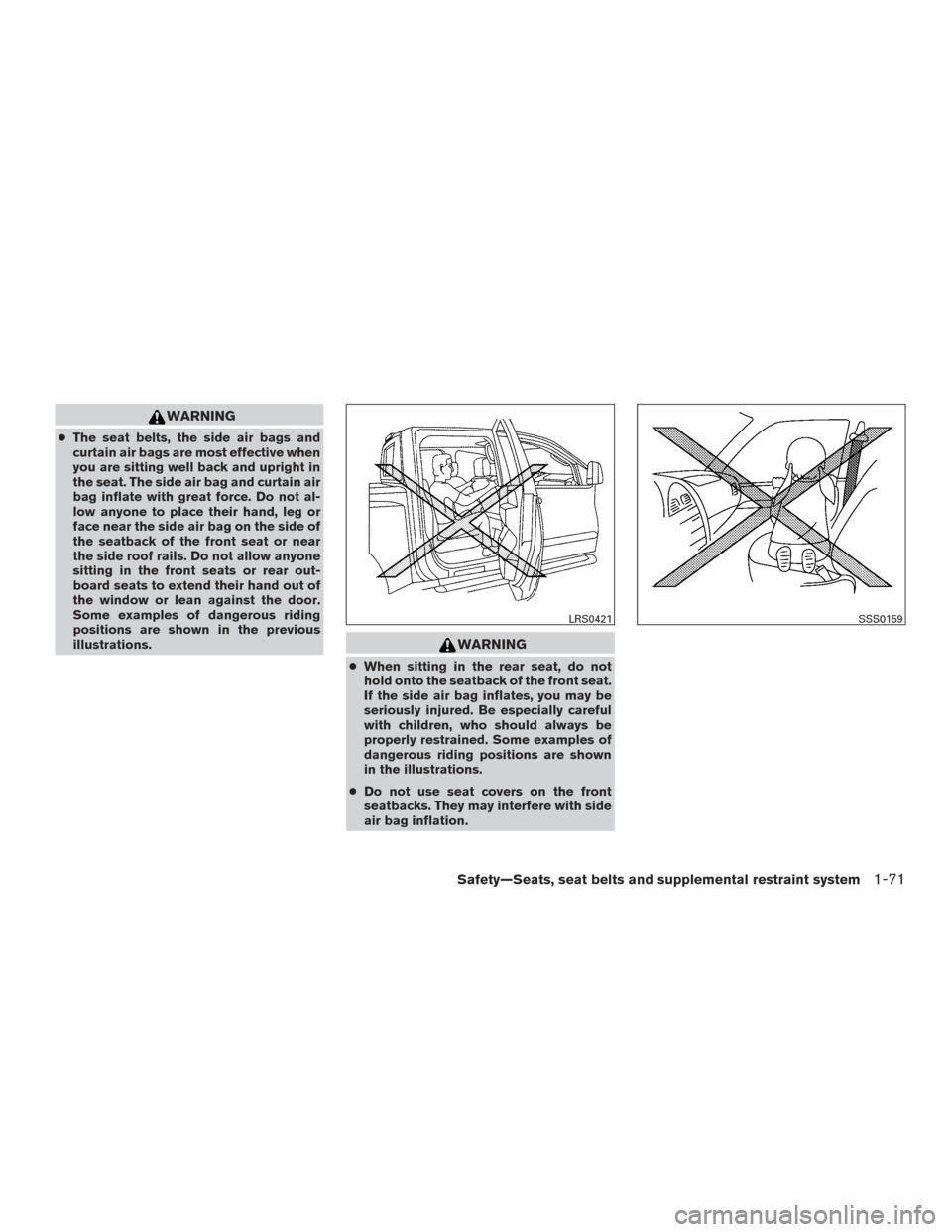
WARNING
●The seat belts, the side air bags and
curtain air bags are most effective when
you are sitting well back and upright in
the seat. The side air bag and curtain air
bag inflate with great force. Do not al-
low anyone to place their hand, leg or
face near the side air bag on the side of
the seatback of the front seat or near
the side roof rails. Do not allow anyone
sitting in the front seats or rear out-
board seats to extend their hand out of
the window or lean against the door.
Some examples of dangerous riding
positions are shown in the previous
illustrations.
WARNING
● When sitting in the rear seat, do not
hold onto the seatback of the front seat.
If the side air bag inflates, you may be
seriously injured. Be especially careful
with children, who should always be
properly restrained. Some examples of
dangerous riding positions are shown
in the illustrations.
● Do not use seat covers on the front
seatbacks. They may interfere with side
air bag inflation.
LRS0421SSS0159
Safety—Seats, seat belts and supplemental restraint system1-71